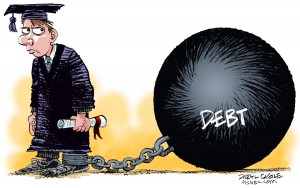Student debt is exploding, burdening some 40 million borrowers with an often crippling obligation that can take decades to pay off.
“The reality of student debt is honestly just now starting to sink in. We see the percentage of home ownership by the age of 30 dropping from 33 percent to 23 percent among individuals with student debt,” said Daniel Haitz of the college planning website eduSquared. “That’s a startling trend that has only occurred in the last 10 years. What’s crazier is that student debt in America grew at 7 percent last year and isn’t showing signs of stopping.”
From 2008 to 2014, student loan debt surged by 84 percent, according to a study by Experian. The $1.2 trillion in student debt now surpasses home equity loans and lines of credit, credit card and automotive debt.
“Once in debt, interest is your companion every minute of the day and night; you cannot shun it or slip away from it; you cannot dismiss it; it yields neither to entreaties, demands, or orders; and whenever you get in its way or cross its course or fail to meet its demands, it crushes you.” J. Reuben Clark (in Conference Report, Apr. 1938, 103)
For those considering financial aid, there are ways to tame student debt. Some of the best solutions are the most simple.
Before College
Starting to save for college as early and systematically as possible is one of the most reliable strategies to limit student loan dependency.
Setting aside just $100 a month in an educational savings account earning a modest 6 percent a year can grow to more than $16,000 over 10 years and $49,000 over 20 years.
So-called “529 accounts” offer a way to save with significant tax breaks (for instance, any funds used to pay for qualifying educational purposes can be withdrawn tax-free.)
Another potential debt buster is the choice of school, for the first year or two.
“Community college credits typically have a 70 percent discount,” said Haitz. “A lab science is a lab science. These types of classes are perfect for transferring into schools.”
The Debt Beast
There are choices that can lessen the burden.
First, file the Free Application for Federal Student Aid (FAFSA) to see if you qualify for federal and state grants, which do not have to be paid back.
If grants aren’t available and you need a loan, don’t overborrow. As Zina Kumok of the blog Debt Free After Three pointed out, many students automatically accept whatever loan amount they’re offered: “Try taking out less. Students should try to work part-time and pay for some of their expenses.”
“If students must borrow money, they should only borrow enough to cover their unmet direct costs – tuition and fees,” added Collins.
Different loans have different features. For example, federal loans charge less interest than private loans and offer more favorable repayment terms. While many private loans require borrowers to begin paying them back while still on school, federal loans don’t mandate payback until the student graduates, leaves school or cuts back attendance to less than half time. Re-evaluating your situation regularly can reduce the need to borrow.
Paying It Back
Paying more than the monthly minimum on a student loan will reduce the overall interest cost. That could either be done with a larger monthly payment or multiple payments per month.
Another option is to start paying loans back while you’re still in school, even though it may not be required.
“The sooner students pay their loans in full, the less interest they will pay,” said Collins. “Federal student loans offer generous deferment, forbearance and forgiveness programs.”
Another option to consider is consolidating multiple loans into a single loan, which can reduce the total monthly payout and extend the timeframe for repayment. But take into account consolidation has costs and limits flexibility in paying down your overall debt.
It may also be advantageous to refinance several high-interest private loans into a single loan – particularly if a parent or someone else co-signed on the original loan.
Jeff Wuorio
Deseret News

